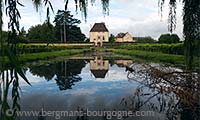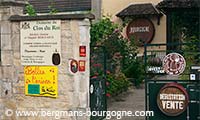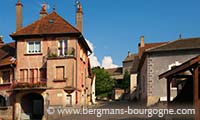
olnay is roughly half the size of its neighbour to the north, Pommard. The name derives from Volen, the god of water. Some 300 people live here and, as Serena Sutcliffe points out in her book "Wines of Burgundy", most of them seem to be called Rossignol. As with Pommard this is red wine country. Located at the top of its vineyards this is a very quiet village. No matter which day I come here I always get the feeling of a lazy Sunday. The shaded village square by the mairie has a lovely view over the vineyards, with the Le Village (premier cru, despite the name) and Bousse d'Or climats right below, together with the local petanque court. Its steep and narrow streets will make your car feel bigger.
Driving our Volvo V70 here I get the feeling of trying to manoeuvre a monster truck through the streets.
 In 1250 Hugues IV built a chateau in Volnay – back then it was Vollenay – that would become the summer residence for the Dukes of Burgundy. The place was highly appreciated because of the lovely surroundings, the air and the wine. The chateau consisted of several buildings and was surrounded by a moat, all located on what today is the village square. In his book on the history of Volnay, published in 1887, abbé Bavard tells us that it also served as shelter for the villagers during unruly times.
In 1250 Hugues IV built a chateau in Volnay – back then it was Vollenay – that would become the summer residence for the Dukes of Burgundy. The place was highly appreciated because of the lovely surroundings, the air and the wine. The chateau consisted of several buildings and was surrounded by a moat, all located on what today is the village square. In his book on the history of Volnay, published in 1887, abbé Bavard tells us that it also served as shelter for the villagers during unruly times.
The chateau was damaged during the French Wars of Religion in the late 16th century. After that it was neglected and left to fall apart. In 1749 a Monsieur Grozelier in Beaune, who would use it as building material, bought what was left of it.
 During this period, and for many centuries to come, Volnay enjoyed tremendous popularity. Later on Louis XI would take special interest in the wines of Volnay, buying several of the best vineyards, such as Caillerets, Bousse d'Or, Champans, Fremiets and Taillepieds.
During this period, and for many centuries to come, Volnay enjoyed tremendous popularity. Later on Louis XI would take special interest in the wines of Volnay, buying several of the best vineyards, such as Caillerets, Bousse d'Or, Champans, Fremiets and Taillepieds.
Up until recently there were 34 premier crus in Volnay, but no grand crus. The premier crus represent an unusually large portion of the village's land, more than 50 percent. From the 2006 vintage there have been some changes. Some of the premier crus have been joined together – Les Aussy is now part of Le Ronceret, En L'Ormeau is part of Les Mitans, Chanlin is part of Pitures and Carelle sous la Chapelle and Carelles-Dessous have become Carelle-Dessous la Chapelle.
 When Dr Lavalle published his "Histoire et Statistique de la Vigne et des Grands Vins de la Côte d'Or" in 1855 he singled out Les Caillerets and Champans; placing them in the top category Tête de Cuvée together with En Chevret, En Fremiers, En Bouze-d'Or, Les Angles, Pointe-d'Angles, La Barre, Carelle-sous-la-Chapelle, En l'Ormeau and Les Mitans. He pointed out that Volnay, alongside Beaune, is the commune that produces the largest number of excellent wines.
When Dr Lavalle published his "Histoire et Statistique de la Vigne et des Grands Vins de la Côte d'Or" in 1855 he singled out Les Caillerets and Champans; placing them in the top category Tête de Cuvée together with En Chevret, En Fremiers, En Bouze-d'Or, Les Angles, Pointe-d'Angles, La Barre, Carelle-sous-la-Chapelle, En l'Ormeau and Les Mitans. He pointed out that Volnay, alongside Beaune, is the commune that produces the largest number of excellent wines.
Before that, in 1831, Denis Morelot wrote in his "La Vigne et le Vin en Côte-d'Or" that "When leaving Meursault the first one encounters is the Santenots, which when cellared can rival the best wines of the Côte d'Or" and added that the Caillerets produces a wine of great delicacy and that Champans is one of the best climats of the commune.
 All the premier cru land forms a large rectangle mid-slope, surrounding the Autun road. Above and below you find the village appellation vines. Les Caillerets, Champmans and Clos des Chênes are by far the largest premiers crus, all located south of the village. Both Les Caillerets (14,34 ha) and Champmans lie just below the Autun road on the Meursault side of the village, while Clos des Chênes (15,41 ha) is just above the same road. All three are split between a large number of owners – there are some 30 different owners for Clos des Chênes, around 20 for Les Caillerets and around 15 for Champmans. Les Caillerets also contains the Clos des 60 Ouvrées, a 2,39 ha monopole owned by Domaine de la Pousse d'Or in Volnay.
All the premier cru land forms a large rectangle mid-slope, surrounding the Autun road. Above and below you find the village appellation vines. Les Caillerets, Champmans and Clos des Chênes are by far the largest premiers crus, all located south of the village. Both Les Caillerets (14,34 ha) and Champmans lie just below the Autun road on the Meursault side of the village, while Clos des Chênes (15,41 ha) is just above the same road. All three are split between a large number of owners – there are some 30 different owners for Clos des Chênes, around 20 for Les Caillerets and around 15 for Champmans. Les Caillerets also contains the Clos des 60 Ouvrées, a 2,39 ha monopole owned by Domaine de la Pousse d'Or in Volnay.

Many of the premiers crus in Volnay are small, often covering less than one hectare. In many cases they are monopoles; Clos de la Bousse d'Or and Clos de l'Audignac are owned by Domaine de la Pousse d'Or, Clos de la Barre by Maison Louis Jadot, Clos de la Chapelle by Domaine Louis Boillot, Clos de Château des Ducs by Domaine Michel Lafarge, Clos de la Rougeotte by Domaine François Buffet, Clos du Verseuil by Domaine Yvon Clerget and Clos des Ducs by Domaine Marquis d'Angerville. With the exception of Clos des 60 Ouvrées all the monopoles are located very close to the village.
Then there is the peculiarity of Les Santenots. This is actually located outside the commune of Volnay, in Meursault. If planted with pinot noir it makes Volnay-Santenots, if planted with chardonnay it makes Meursault Premier Cru or Meursault Santenots.
– Volnay Santenots and Volnay Ronceret are big wines with strong tannins, but the tannins are integrated in the wine, says Nicolas Rossignol at Domaine Nicolas Rossignol in Volnay. If you take a Pommard, even if it is a fine and elegant wine, you first have the wine when you taste, then the tannins take its place. The finish is just tannins, even if it is very elegant tannins.
 Unlike Pommard, which is located on what was once a riverbed and that has a valley behind the village leading up into the Hautes-Côtes, Volnay is only one single slope with roughly the same exposition for all the vines.
Unlike Pommard, which is located on what was once a riverbed and that has a valley behind the village leading up into the Hautes-Côtes, Volnay is only one single slope with roughly the same exposition for all the vines.
– Volnay is only one hill, continues Nicolas Rossignol. But because of the slope and the erosion the soil is being transported further down the hill. The soil in Ronceret is very poor. The roots of the vines go down very deep. The wine is full of dark fruits. Blackberries, blueberries – that kind of fruit. There are no flavours of red fruits or flowers. But there is a lot of minerality.
In his book Denis Morelot also tells us that in the past Volnay produced what they called a vin de primeur, a wine which was only left in the vats for a few hours, just so the fermentation would start. The grapes were then pressed and the juice put ino barrels where it would develop under a layer of scum. The wine would then be ready to drink the following year.
© 2013 Ola Bergman













